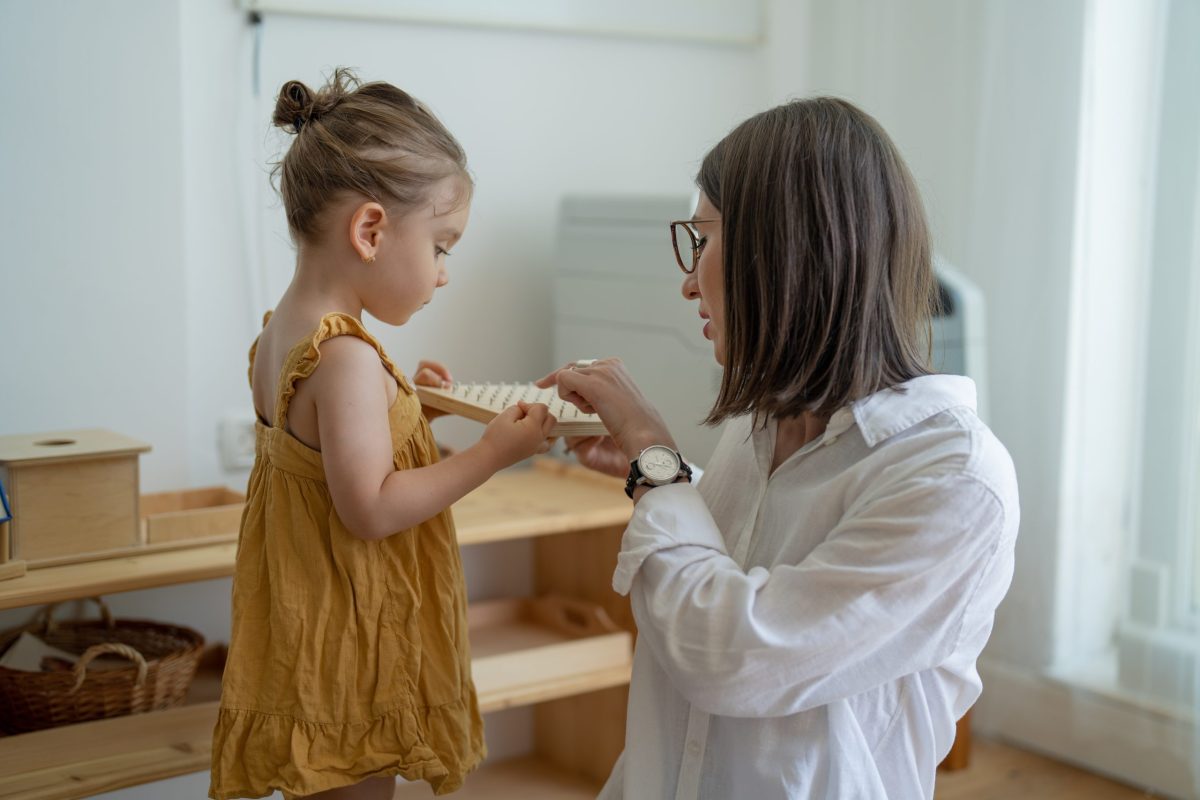Montessori Grace and Courtesy
Montessori isn’t just concerned with teaching children academic subjects. It focuses on whole-child development, including how to help children be kind, courteous contributors to society. This is where Montessori grace and courtesy come in.
Grace and courtesy lessons teach children simple social skills like how to greet a new person, the most polite way to cough around other people, and how to eat at the table. Montessori educators may teach formal grace and courtesy lessons during circle time or in another low-stress moment of the day. They also teach grace and courtesy by modeling respectful behaviors in all their interactions.
In Montessori, learning grace and courtesy is about more than just the specific skills and words children learn to use. Instead, children are guided to understand the importance of boundaries, polite gestures, and social skills while learning how their actions affect others. Let’s explore how a Montessori homeschool environment and grace and courtesy lessons build meaningful relationships and a strong sense of self!

What Do Montessori Grace and Courtesy Lessons Teach Children?
Adults often forget that when a child is born, they don’t automatically understand social norms like saying goodbye, how to regulate emotions, or how to express thanks. These skills have to be taught and, more importantly, modeled.
Humans are also naturally social, which comes with its own set of social skills and rules that we have to keep up with, like modeling active listening and having conflicts.
Aside from modeling, Montessori grace and courtesy lessons break these norms into smaller chunks. Each grace and courtesy presentation aims to guide children in respectfully interacting with others, their environments, and themselves.
Through these lessons, children become active members of their environment and the wider community. They feel more secure and empowered because they have the tools and sense of order to navigate the world around them.
How To Model Montessori Grace and Courtesy at Home
You can help your child build their grace and courtesy skills by role modeling, observing, and guiding with these home tips.
Show Intentional Behavior
Whether you realize it or not, children are always watching us. You will know what I mean if you have ever said or done something you shouldn’t have and seen your child repeat it. That’s where modeling intentional behavior comes in.
For example, you might be disagreeing with your partner when emotions begin running high and you feel ready to burst (we’ve all been there!) Rather than hiding your emotions in those moments, show your child how to deal with them respectfully. Model that it’s OK to walk away for a minute if they feel overwhelmed or to breathe in and out if they feel anxious or angry. You can tell them what you’re doing and why by saying, “I’m walking away for a minute because I am frustrated.”
It is better to model to them that they can walk away from an uncomfortable situation than to shout loudly and aggressively. When walking away isn’t possible, you can model mindfulness techniques like counting to 10 or slowing down your breathing.
Communicate Respectfully

Showing intentional behavior and modeling grace and courtesy are also linked to communicating respectfully. If you can, explain your feelings with “I feel like” or “I feel like this when” statements so children feel encouraged to do the same.
Another aspect of respectful communication is active listening. Respectful listening is about using appropriate supportive body language, repeating and rephrasing, and not interrupting your child. Give your child eye contact, and do not rush into fixing problems. Guide them to come up with solutions by asking them questions like, “How did that make you feel?” or “How can we work together?”
Model Polite Behaviors
You can show them good examples of polite behaviors by modeling them yourself. You don’t have to be perfect, but trying your best to say please and thank you and respecting another person’s boundaries will go a long way! Habits like speaking calmly, opening doors for others, and sharing freely are also important to model.
Enforce and Respect Boundaries
Boundaries are how we keep ourselves safe and secure and our relationships with others healthy. When children are young, it can be difficult for them to understand why boundaries are important, especially for someone they don’t know or care about.
 Children will learn how to respectfully set and respect boundaries as they see you do the same in your interactions with them and others. For example, if your child is trying to hit you, you may calmly block their hand and say, “I can’t let you hit me.” If you’re speaking with a family member who takes a conversation in a direction you’re not comfortable with, you may say, “I hear your concerns. I’m not comfortable discussing this right now.”
Children will learn how to respectfully set and respect boundaries as they see you do the same in your interactions with them and others. For example, if your child is trying to hit you, you may calmly block their hand and say, “I can’t let you hit me.” If you’re speaking with a family member who takes a conversation in a direction you’re not comfortable with, you may say, “I hear your concerns. I’m not comfortable discussing this right now.”
Children are more likely to mimic these behaviors if they hear them often. Work on modeling behaviors like asking others if they are on the same page before making decisions or asking before giving hugs and physical contact.
Another important related positive parenting principle is honoring consent and body autonomy. For example, while changing your child’s diaper, you can talk to them about the process as you change them. For reluctant changers, you may express, “Oh, look, your diaper is wet and heavy. Let’s change it together.”
You can also honor your child’s autonomy and boundaries by letting your child show affection in their own time and way, rather than forcing them to give hugs or other physical contact to friends or family members.
Simple Montessori Grace and Courtesy Activities
In addition to modeling, Montessori grace and courtesy lessons teach children skills and behaviors step-by-step. Here are some ideas to try at home:
- During your Montessori circle time, you may role-play different scenarios. For example, your child can practice asking someone for help, asking if they can move by, asking for permission, or inviting someone to play with them.
- Learn about other cultures and explore the earth to help children develop empathy and understanding toward different people.
- Give comfort to someone in need.
- Ask if someone needs help.
- Choose and give a gift.
- Serve food or drinks to others.
- Help a grandparent or someone else in need.
- Encourage your child to have a say in household routines to promote open communication and trust. You may organize a weekly family catch-up or a suggestions box.
- To practice gratitude, you can encourage children to write, draw, or say something they are thankful for.
- To promote appreciation and being mindful of our actions, you can also encourage reflection time through journals or diaries.
- Practice how we greet others and say goodbye through role-playing and modeling.
- Work together on sharing toys through projects and outdoor play.
Creating a Montessori Peace Table
A Montessori peace table is a time-tested approach in Montessori homes and classrooms to teach grace and courtesy skills. It’s a quiet and calming space where children can reflect, resolve conflicts, and communicate their feelings.
The peace table isn’t about punishment; it’s about conflict resolution. You can model how to use it with your child by role-playing and inviting someone to the space. Peace tables are very adaptable, but some things to include could be cushions, an hourglass timer, some “I” statement cards, or an object signifying they’re ready to communicate respectfully.
Interacting with the Environment
 Part of Montessori grace and courtesy is learning how to interact with the environment respectfully. You can model this by ensuring everything has a place, perhaps in baskets or on shelves.
Part of Montessori grace and courtesy is learning how to interact with the environment respectfully. You can model this by ensuring everything has a place, perhaps in baskets or on shelves.
Encouraging children to tidy up after themselves and maintain order fosters responsibility and consideration for others. Our Helping Hands Toolbox is a great resource to help children learn the skills they need to do so!
Interacting with the environment also means how we walk around it. You can model walking around obstacles slowly and with exaggerated gestures. This aspect of Montessori grace and courtesy teaches spatial awareness and consideration for those sharing the environment.
Raising Courteous Kids
Raising courteous, helpful kids doesn’t happen overnight. Don’t be surprised if grace and courtesy lessons take time and repetition to become reality. As you consistently model and teach these principles, they will eventually sink in.
Have Montessori grace and courtesy lessons been an effective tool for your family? Let us know in the comments here or on social media!




0 Comments